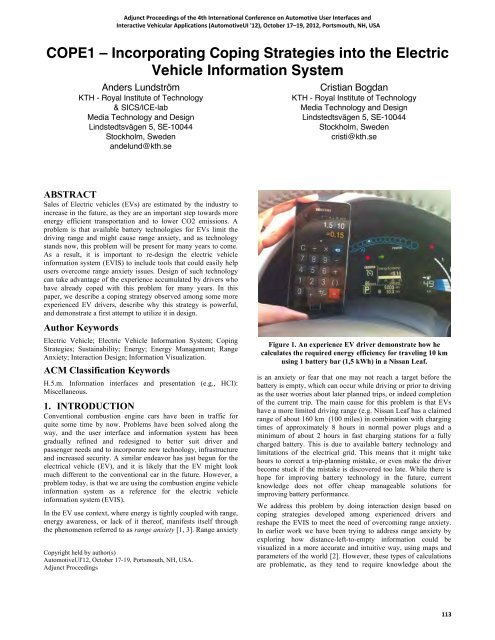12: Adjunct Proceedings - Automotive User Interfaces and ...
12: Adjunct Proceedings - Automotive User Interfaces and ...
12: Adjunct Proceedings - Automotive User Interfaces and ...
You also want an ePaper? Increase the reach of your titles
YUMPU automatically turns print PDFs into web optimized ePapers that Google loves.
COPE1 – Incorporating Coping Strategies into the Electric<br />
Vehicle Information System<br />
Anders Lundström<br />
KTH - Royal Institute of Technology<br />
& SICS/ICE-lab<br />
Media Technology <strong>and</strong> Design<br />
Lindstedtsvägen 5, SE-10044<br />
Stockholm, Sweden<br />
<strong>and</strong>elund@kth.se<br />
ABSTRACT<br />
Sales of Electric vehicles (EVs) are estimated by the industry to<br />
increase in the future, as they are an important step towards more<br />
energy efficient transportation <strong>and</strong> to lower CO2 emissions. A<br />
problem is that available battery technologies for EVs limit the<br />
driving range <strong>and</strong> might cause range anxiety, <strong>and</strong> as technology<br />
st<strong>and</strong>s now, this problem will be present for many years to come.<br />
As a result, it is important to re-design the electric vehicle<br />
information system (EVIS) to include tools that could easily help<br />
users overcome range anxiety issues. Design of such technology<br />
can take advantage of the experience accumulated by drivers who<br />
have already coped with this problem for many years. In this<br />
paper, we describe a coping strategy observed among some more<br />
experienced EV drivers, describe why this strategy is powerful,<br />
<strong>and</strong> demonstrate a first attempt to utilize it in design.<br />
Author Keywords<br />
Electric Vehicle; Electric Vehicle Information System; Coping<br />
Strategies; Sustainability; Energy; Energy Management; Range<br />
Anxiety; Interaction Design; Information Visualization.<br />
ACM Classification Keywords<br />
<strong>Adjunct</strong> <strong>Proceedings</strong> of the 4th International Conference on <strong>Automotive</strong> <strong>User</strong> <strong>Interfaces</strong> <strong>and</strong><br />
Interactive Vehicular Applications (<strong>Automotive</strong>UI '<strong>12</strong>), October 17–19, 20<strong>12</strong>, Portsmouth, NH, USA<br />
H.5.m. Information interfaces <strong>and</strong> presentation (e.g., HCI):<br />
Miscellaneous.<br />
1. INTRODUCTION<br />
Conventional combustion engine cars have been in traffic for<br />
quite some time by now. Problems have been solved along the<br />
way, <strong>and</strong> the user interface <strong>and</strong> information system has been<br />
gradually refined <strong>and</strong> redesigned to better suit driver <strong>and</strong><br />
passenger needs <strong>and</strong> to incorporate new technology, infrastructure<br />
<strong>and</strong> increased security. A similar endeavor has just begun for the<br />
electrical vehicle (EV), <strong>and</strong> it is likely that the EV might look<br />
much different to the conventional car in the future. However, a<br />
problem today, is that we are using the combustion engine vehicle<br />
information system as a reference for the electric vehicle<br />
information system (EVIS).<br />
In the EV use context, where energy is tightly coupled with range,<br />
energy awareness, or lack of it thereof, manifests itself through<br />
the phenomenon referred to as range anxiety [1, 3]. Range anxiety<br />
Copyright held by author(s)<br />
<strong>Automotive</strong>UI'<strong>12</strong>, October 17-19, Portsmouth, NH, USA.<br />
<strong>Adjunct</strong> <strong>Proceedings</strong><br />
Cristian Bogdan<br />
KTH - Royal Institute of Technology<br />
Media Technology <strong>and</strong> Design<br />
Lindstedtsvägen 5, SE-10044<br />
Stockholm, Sweden<br />
cristi@kth.se<br />
Figure 1. An experience EV driver demonstrate how he<br />
calculates the required energy efficiency for traveling 10 km<br />
using 1 battery bar (1,5 kWh) in a Nissan Leaf.<br />
is an anxiety or fear that one may not reach a target before the<br />
battery is empty, which can occur while driving or prior to driving<br />
as the user worries about later planned trips, or indeed completion<br />
of the current trip. The main cause for this problem is that EVs<br />
have a more limited driving range (e.g. Nissan Leaf has a claimed<br />
range of about 160 km (100 miles) in combination with charging<br />
times of approximately 8 hours in normal power plugs <strong>and</strong> a<br />
minimum of about 2 hours in fast charging stations for a fully<br />
charged battery. This is due to available battery technology <strong>and</strong><br />
limitations of the electrical grid. This means that it might take<br />
hours to correct a trip-planning mistake, or even make the driver<br />
become stuck if the mistake is discovered too late. While there is<br />
hope for improving battery technology in the future, current<br />
knowledge does not offer cheap manageable solutions for<br />
improving battery performance.<br />
We address this problem by doing interaction design based on<br />
coping strategies developed among experienced drivers <strong>and</strong><br />
reshape the EVIS to meet the need of overcoming range anxiety.<br />
In earlier work we have been trying to address range anxiety by<br />
exploring how distance-left-to-empty information could be<br />
visualized in a more accurate <strong>and</strong> intuitive way, using maps <strong>and</strong><br />
parameters of the world [2]. However, these types of calculations<br />
are problematic, as they tend to require knowledge about the<br />
113





